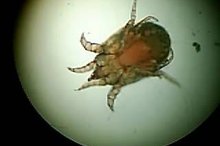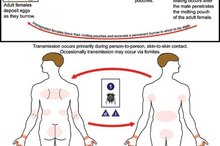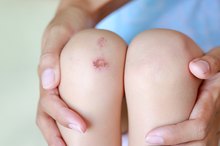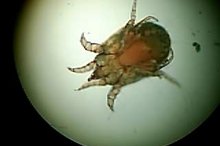What does fact checked mean?
At Healthfully, we strive to deliver objective content that is accurate and up-to-date. Our team periodically reviews articles in order to ensure content quality. The sources cited below consist of evidence from peer-reviewed journals, prominent medical organizations, academic associations, and government data.
The information contained on this site is for informational purposes only, and should not be used as a substitute for the advice of a professional health care provider. Please check with the appropriate physician regarding health questions and concerns. Although we strive to deliver accurate and up-to-date information, no guarantee to that effect is made.
If you've been infested with scabies, also known as the "human itch mite," you may not know it for some time 2. According to the Centers for Disease Control, while scabies is more common in conditions where people live close together, such as jails and extended-care facilities, the mite doesn't discriminate based on race, class, gender or hygiene 2. Being alert to the first signs of scabies allows you to cure this itchy skin condition before you pass the mites on to others 2.
Scabies Life Cycle
The average scabies mite has a lifespan of one to two months and has four life stages: egg, larva, nymph and adult 2. All it takes is one impregnated female scabies mite to result in a human infestation 2. The female mite burrows under the skin, where she deposits two to three eggs every day. After the eggs hatch, larvae emerge and make their way to the surface of the skin for another three to four days. After the larvae molt, they turn into nymphs; after another molting process, the adult female scabies are ready to breed with smaller male mites that linger in small pits in the skin 2. The newly-pregnant female mite creates a new burrow, and the life cycle begins all over again.
Scabies & Human Hosts
How Long Can Scabies Eggs Live?
Learn More
Scabies are microscopic and cannot be visualized on your skin 2. Female mites are are 0.30 to 0.45 millimeter in length and 0.25 to 0.35 millimeter in width. Males are roughly half the size of their female counterparts. There is a lag time between the time a human infestation occurs and when signs such as noticeable burrows, rash and symptoms of intense itching begin--typically between two and six weeks, according to the CDC. During this time, someone infested with scabies can still pass the mites onto others through close, skin-to-skin contact 2. Adults typically acquire scabies through sexual contact with an infested partner 2.
Earliest Signs of Scabies
If you have scabies, the first sign you may notice is itching that is more intense at night than during the day 2. Itching gives rise to a red, pimply rash. You may also note the presence of scabies burrows in specific parts of your body 2. In adults, scabies prefer areas of skin that fold or touch each other, so you may note small, slightly raised serpentine ridges in the webbing between your fingers, inside your wrists or elbows, under your breasts or genital area, or between the shoulder blades 2. In children, scabies prefer to take up residence in the neck, scalp, soles and palms 2.
Scabies Treatment
What Are Skin Symptoms of Mites?
Learn More
Treating scabies requires a visit to the doctor to first identify the infestation 2. While an experienced dermatologist can often diagnose scabies by noting the presence of burrows, skin culture tests can confirm a scabies infestation 2. Treating scabies requires purchase of a prescription topical medication that contains either permethrin or crotamiton 2. These topical applications are applied all over the body from the neck down and left on for a certain number of hours and then thoroughly washed off. Although this kills the mites and their eggs, many people still experience itching as the remnants of the mites and their feces continue to cause an allergic reaction in the skin for a week or sometimes longer.
Other Preventive Measures
Scabies mites cannot live very long without the blood of a human host--usually no more than 72 hours (three days) 2. An important part of eradicating scabies and preventing a reinfestation is ensuring that all clothing, linens, towels and other personal items are thoroughly washed in hot water and dried on high heat 2. Things that cannot be laundered can be stored in containers or garbage bags and placed outside of the home for three days until the mites die of starvation.
Related Articles
References
- CDC: Scabies Lifecycle
- Nih.Gov: Scabies
- Scabies. World Health Organization.. May 20, 2019.
- CDC - Scabies - Disease. Centers for Disease Control and Prevention. Nov 2, 2010.
- Harvard Health Publishing. Scabies. Harvard Health. Dec 2018.
- Mrázová Z, Jadrníčková I, Brabcová K, Spurný F. Fragmentation of Ne ions with energy 400 MeV/u behind targets from different materials measured with PNTD. Radiation Measurements. 2010;45(10):1438-1440. doi:10.1016/j.radmeas.2010.06.048.
- Patel VM, Lambert WC, Schwartz RA. Safety of Topical Medications for Scabies and Lice in Pregnancy. Indian J Dermatol. 2016;61(6):583-587. doi:10.4103/0019-5154.193659
- CDC - Scabies - Resources for Health Professionals - Medications. Centers for Disease Control and Prevention. Oct 2, 2019.
- CDC - Scabies - General Information - Frequently Asked Questions (FAQs). Centers for Disease Control and Prevention. Oct 24, 2018.
- Arlian LG, Morgan MS. A review of Sarcoptes scabiei: past, present and future. Parasit Vectors. 2017 Jun 20;10(1):297. doi: 10.1186/s13071-017-2234-1.
- CDC. Scabies. Resources for Health Professionals, Medications.
- Micali G, Lacarrubba F, Verzì AE, Chosidow O, Schwartz RA. Scabies: Advances in Noninvasive Diagnosis. PLoS Negl Trop Dis. 2016 Jun 16;10(6):e0004691. doi: 10.1371/journal.pntd.0004691. eCollection 2016 Jun.
Writer Bio
Lisa Sefcik has been writing professionally since 1987. Her subject matter includes pet care, travel, consumer reviews, classical music and entertainment. She's worked as a policy analyst, news reporter and freelance writer/columnist for Cox Publications and numerous national print publications. Sefcik holds a paralegal certification as well as degrees in journalism and piano performance from the University of Texas at Austin.









